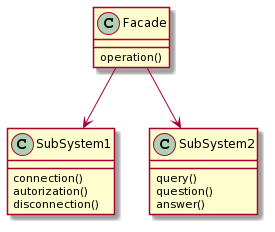Jeśli moja strona Ci pomogła, i chcesz aby była bardziej rozwijana, wesprzyj mnie buy me a coffee
|
I. Wzorce kreacyjne 1. Singleton 2. Budowniczy 3. Prototyp 4. Fabryka 5. Fabryka abstrakcyjna II. Wzorce strukturalne 1. Adapter 2. Most 3. Kompozyt 4. Dekorator 5. Fasada 6. Pyłek 7. Pełnomocnik III. Wzorce czynnościowe 1. Łańcuch zobowiązań 2. Polecenie 3. Interpreter 4. Iterator 5. Mediator 6. Pamiątka 7. Obserwator 8. Stan 9. Strategia 10. Metoda szablonowa 11. Odwiedzający |
Fasada (facade) - wzorzec projektowy (design pattern) - java1. Cel:Wzorzec fasada (facade) zapewnia uproszczony interfejs dla złożonego lub trudnego w użyciu systemu, który często jest wynikiem źle zaprojektowanego interfejsu API. Jest to wzorzec służący do refaktoryzacji kodu. Upraszcza interface klienta. 2. Problem: Chcemy umożliwić użycie API w łatwiejszy sposób, ukrywając szczególy dla klienta. Przykładem może być gdy jesteśmy w pokoju i mamy kilka pilotów np. TV, Video itp. 3. Rozwiązanie: Tworzymy jedną klasę fasadę która odpowiada za wszystkie zadania. Udostępniamy interface fasadę która odpowiada za sterowanie wszystkimi pilotmi (podsystemami) w jednym miejscu. Uproszczamy system i tworzymy jeden inteface dla grupy klas. 4. Diagram klas wzorca Fasada (facade):  5. Implementacja: Pierwszą klasą jest klasa singleton, klasa służąca do nawiązania połączenia z bazą:
- java.net.URL używa openStream() ukrywając wywołane detale - javax.faces.context.FacesContext używa LifeCycle, ViewHandler, NavigationHandler - javax.faces.context.ExternalContext używa ServletContext, HttpSession, HttpServletRequest, HttpServletResponse i innych. |
|---|